Gare Saint-Lazare
by Claude Monet
Fast Facts
- Year
- 1877
- Medium
- Oil on canvas
- Dimensions
- 54.3 × 73.6 cm
- Location
- National Gallery, London
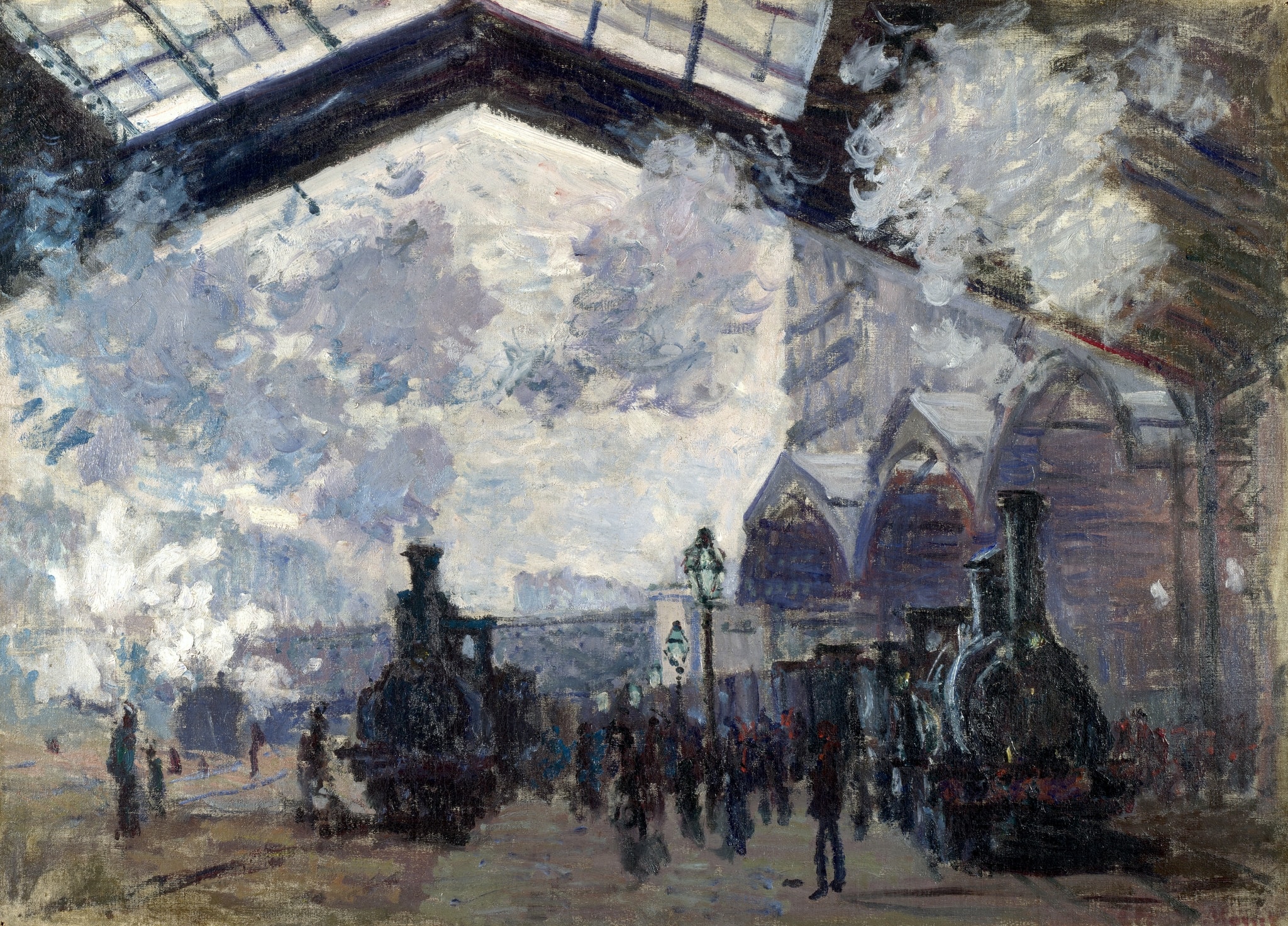
Click on any numbered symbol to learn more about its meaning
Meaning & Symbolism
The meaning of Gare Saint-Lazare is Monet’s claim that modern industry can produce experiences of sublime transience once reserved for landscape: steam becomes cloud, the train shed becomes sky, and urban crowds register as rhythmic pulses of time 12. It matters because the painting codifies Impressionism’s wager that perception—fleeting and contingent—could be the subject of high art within a fully modern setting 14. By staging dissolving plumes against rigid girders, Monet shows how mechanized speed and standard time reorder seeing itself 3. This is why Gare Saint-Lazare is important: it inaugurates his serial method and makes the station a new kind of cathedral of movement at the heart of Paris 14.
Monet organizes the composition around the shed’s sharply receding roof truss, a dark V that funnels the eye toward a pale, vapor-filled core. Within that engineered frame, two squat locomotives read as silhouetted anchors, while clouds of steam—painted in broken violets, blue-grays, and milky whites—rise to occupy the very place a sky would be in a landscape. Passengers and rail workers are rendered as staccato marks that swell and thin across the platform; they function less as portraits than as visual tempi, registering the station’s pulse. The greenish gas lamps puncture the haze and ricochet faint color onto the damp ground. In short, the canvas converts soot, noise, and iron into a choreography of light, translating industrial exhaust into an optical climate. The National Gallery underscores Monet’s inversion of landscape convention—clouds inside, under glass—while avoiding pure black in favor of mixed color to keep the scene optically alive 1. Orsay places this choice within critics’ calls to paint modern life, treating the shed’s geometry as scaffolding for sensation rather than architectural description 2. The deeper argument here concerns modern time. A station is a machine for coordinating departures and arrivals; Monet’s quick, fragmenting brushwork mirrors that new regime of synchronized, clocked time that nineteenth-century rail travel enforced 3. Notice how the image privileges thresholds—trains poised to depart, figures in mid-gesture, steam in mid-dissolve—over endpoints. The haze both conceals and reveals, making legibility contingent and momentary; vision itself becomes a timed event. Read this way, the locomotives’ dark masses are not heroic monuments but counterweights that keep the pictorial tempo from evaporating entirely. The painting also prototypes Monet’s later serial practice: by fixing on a single motif and varying atmosphere and vantage, he treats subject as a constant and time/light as variables—a method that will culminate in the grainstacks and cathedrals 4. Harvard’s related canvas confirms the series’ recurring devices—twin trains, platform figures, and the lamplit haze—showing how Monet systematically tested the motif across conditions 5. Finally, the picture reframes the station as a civic sacred space. The glass canopy performs like a nave; the lamps act as secular candelabra; the crowd gathers not for ritual but for travel. The result is not nostalgia for preindustrial nature but a claim that industrial modernity yields its own forms of the sublime. That is the meaning of Gare Saint-Lazare: an ethics of attention pitched to the urban present, where perception must keep pace with steam, signal, and schedule. And that is why Gare Saint-Lazare is important: it fuses technology and aesthetics into a single image of collective, transitional experience, locating beauty at the exact point where a city learns to see in modern time 1234.Citations
- National Gallery, London – The Gare St-Lazare (collection entry)
- Musée d’Orsay – La Gare Saint-Lazare (object record and essay)
- André Dombrowski, “Impressionism and the Standardization of Time: Claude Monet at Gare Saint-Lazare,” Art Bulletin (2020)
- Art Institute of Chicago – Arrival of the Normandy Train, Gare Saint-Lazare
- Harvard Art Museums – The Gare Saint-Lazare: Arrival of a Train
- Juliet Wilson-Bareau, Manet, Monet, and the Gare Saint-Lazare (NGA/Orsay exhibition catalog, 1998)
Explore Deeper with AI
Ask questions about Gare Saint-Lazare
Popular questions:
Powered by AI • Get instant insights about this artwork
Interpretations
Historical Context
Source: National Gallery, London; Musée d’Orsay; Art Institute of Chicago
Formal Analysis
Source: National Gallery, London
Symbolic Reading
Source: Musée d’Orsay; National Gallery, London
Social Commentary
Source: Juliet Wilson‑Bareau (NGA/Orsay exhibition catalog)
Biographical
Source: Musée d’Orsay; Art Institute of Chicago
Reception History
Source: Musée d’Orsay; National Gallery, London; André Dombrowski
Related Themes
About Claude Monet
More by Claude Monet

Haystacks Series by Claude Monet | Light, Time & Atmosphere
Claude Monet
Claude Monet’s <strong>Haystacks Series</strong> transforms a routine rural subject into an inquiry into <strong>light, time, and perception</strong>. In this sunset view, the stacks swell at the left while the sun burns through the gap, making the field shimmer with <strong>apricot, lilac, and blue</strong> vibrations.

The Artist's Garden at Giverny
Claude Monet (1900)
In The Artist's Garden at Giverny, Claude Monet turns his cultivated Clos Normand into a field of living color, where bands of violet <strong>irises</strong> surge toward a narrow, rose‑colored path. Broken, flickering strokes let greens, purples, and pinks mix optically so that light seems to tremble across the scene, while lilac‑toned tree trunks rhythmically guide the gaze inward <sup>[1]</sup><sup>[3]</sup>.
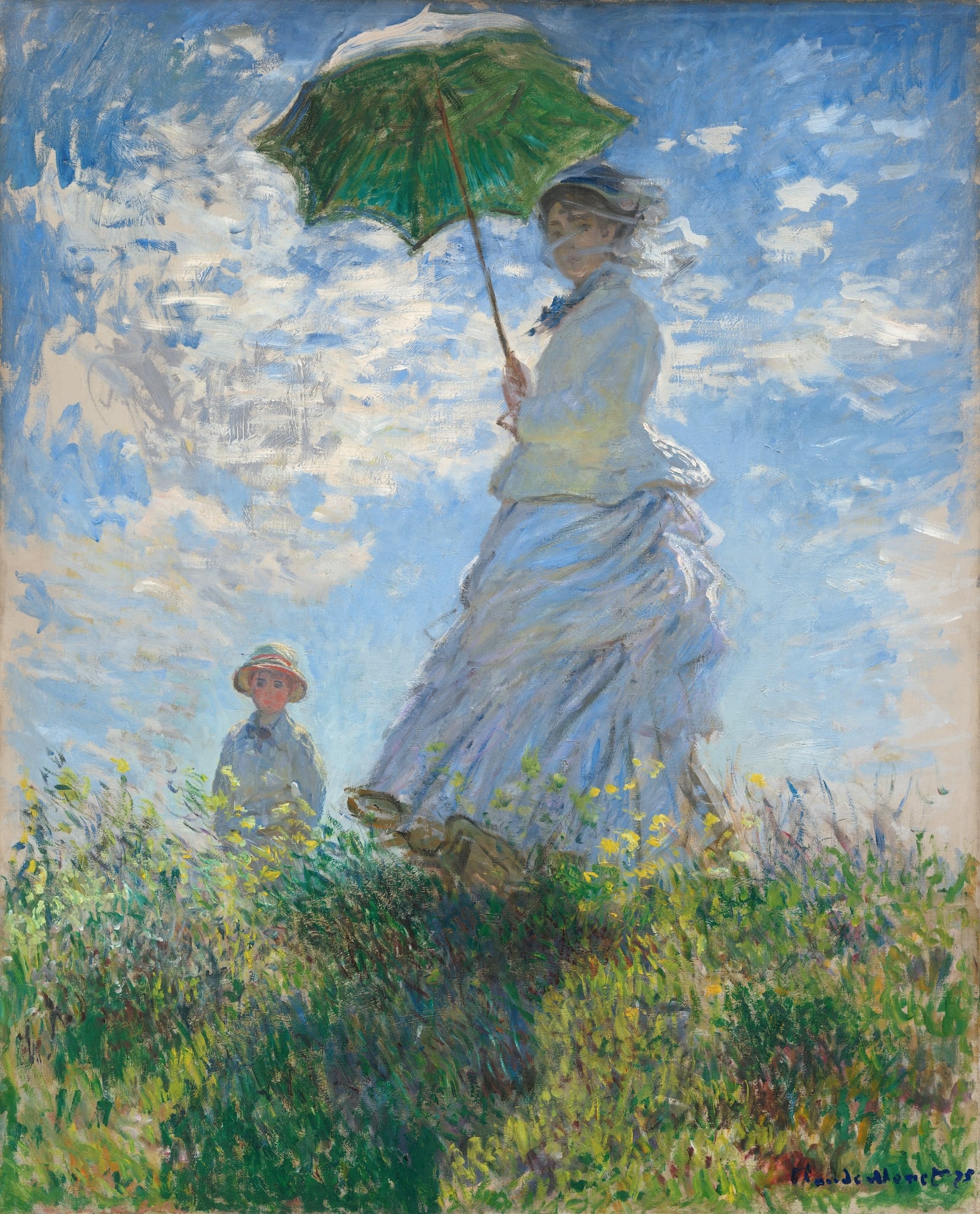
Woman with a Parasol
Claude Monet (1875)
Claude Monet’s Woman with a Parasol fixes a breezy hillside instant in high, shifting light, setting a figure beneath a <strong>green parasol</strong> against a vast, vibrating sky. The low vantage and <strong>broken brushwork</strong> merge dress, clouds, and grasses into one atmosphere, while a child at the rise anchors depth and intimacy <sup>[1]</sup>. It is a manifesto of <strong>plein-air</strong> perception—painting the sensation of air in motion rather than the contours of things <sup>[2]</sup>.
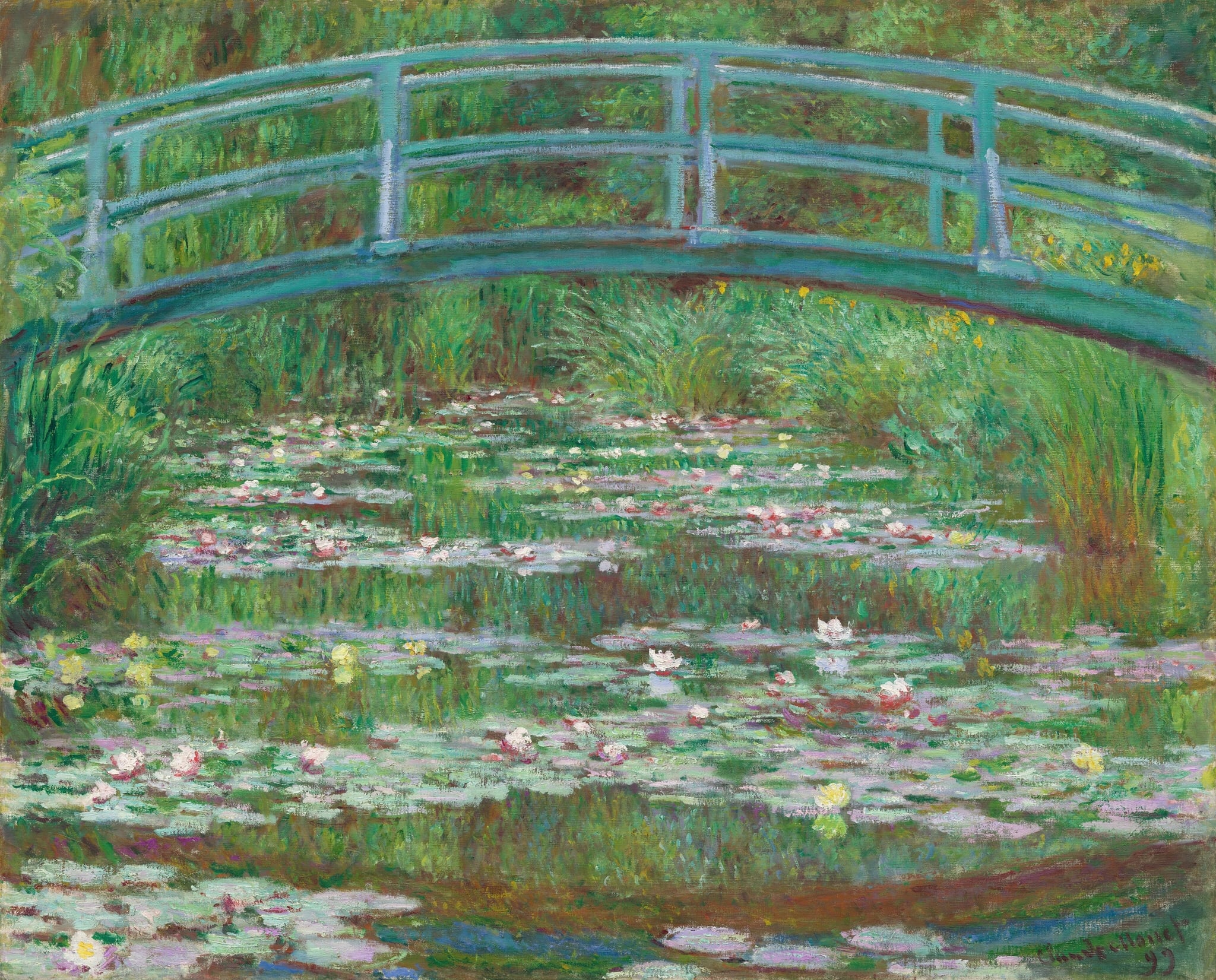
The Japanese Footbridge
Claude Monet (1899)
Claude Monet’s The Japanese Footbridge turns his Giverny garden into an <strong>immersive field of perception</strong>: a pale blue-green arc spans water crowded with lilies, while grasses and willows dissolve into vibrating greens. By eliminating the sky and anchoring the scene with the bridge, Monet makes <strong>reflection, passage, and time</strong> the picture’s true subjects <sup>[1]</sup><sup>[2]</sup>.
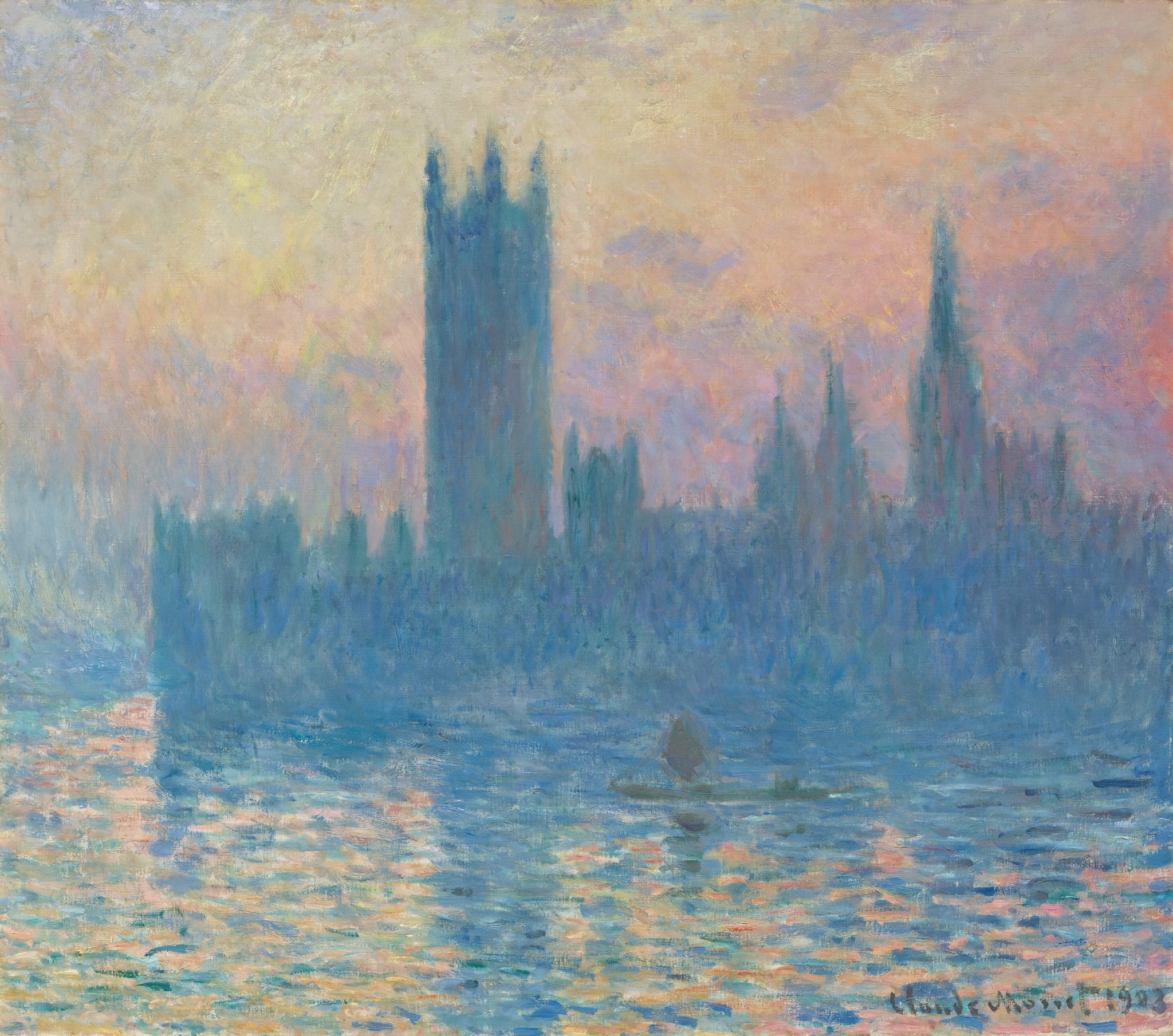
Houses of Parliament
Claude Monet (1903)
Claude Monet’s Houses of Parliament renders Westminster as a <strong>dissolving silhouette</strong> in a wash of peach, mauve, and pale gold, where stone and river are leveled by <strong>luminous fog</strong>. Short, vibrating strokes turn architecture into <strong>atmosphere</strong>, while a tiny boat anchors human scale amid the monumental scene.
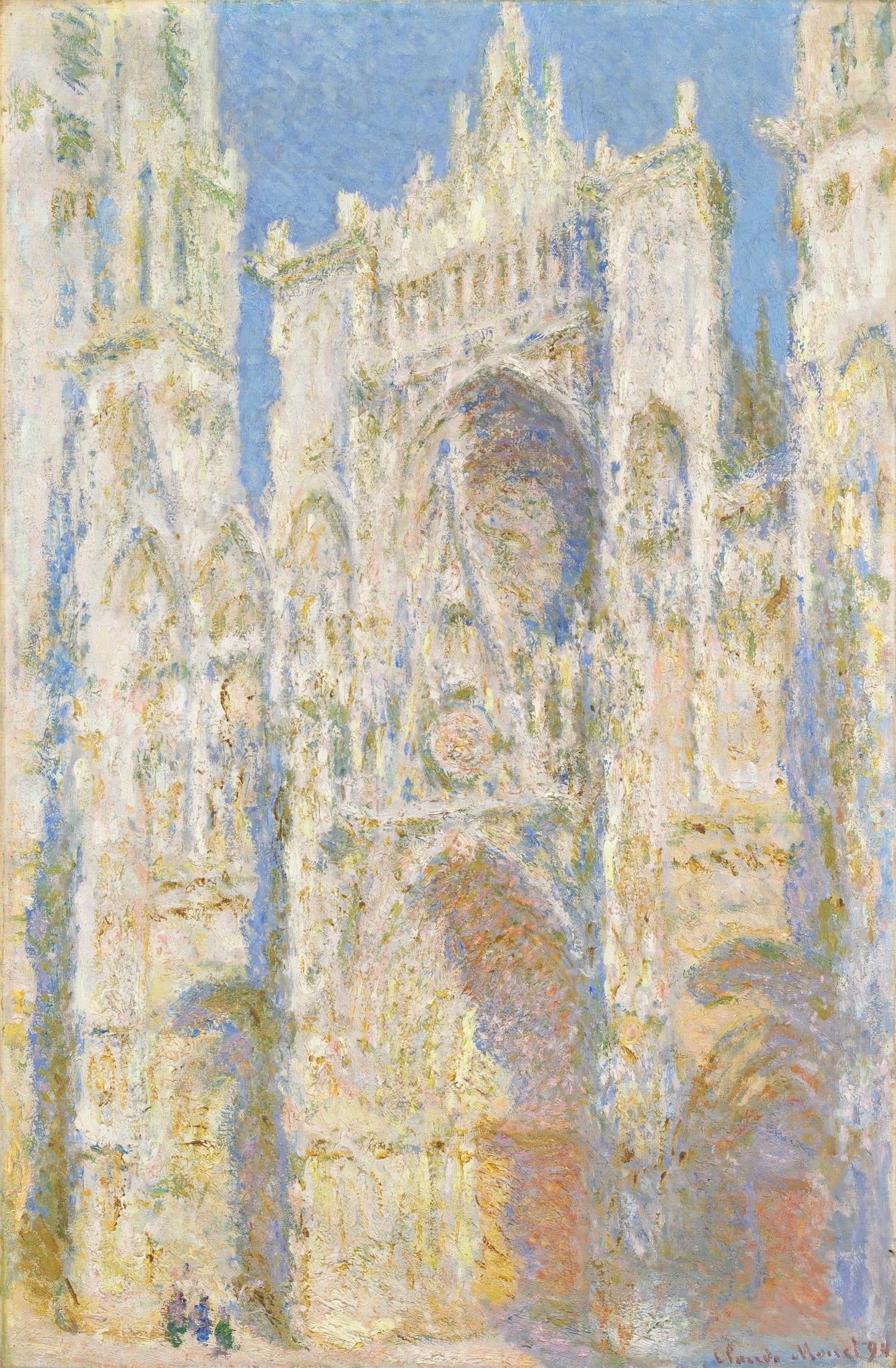
Rouen Cathedral Series
Claude Monet (1894)
Claude Monet’s Rouen Cathedral Series (1892–94) turns a Gothic monument into a laboratory of <strong>light, time, and perception</strong>. In this sunstruck façade, portals, gables, and a warm, orange-tinged rose window flicker in pearly violets and buttery yellows against a crystalline blue sky, while tiny figures at the base anchor the scale. The painting insists that <strong>light—not stone—is the true subject</strong> <sup>[1]</sup><sup>[2]</sup>.